Media | Articles
10 of our favorite oddball cars
Here at Hagerty, we’re a fairly normal bunch. We love the rumble of a good V-8, the smack of a gavel after a record-setting auction, the allure of the wide-open road. You know, normal things.
But every so often—say, on every second Wednesday of the even months—things get deeply, deeply weird. Astute readers will note that this past Wednesday fits that (entirely arbitrary) set of conditions. On that auspicious day, we got our own Brad Phillips on air with Hagerty member and established oddball collector Jerome Reinan to discuss the strange, the eccentric, and the just plain batty vehicles of the world.
If you watched our ’90s cars livestream, you’ll know that Brad has a certain affinity for weirdo rides of all generations. He pulls out all the stops for this livestream, however—mainly to keep up with his guest. As Reinan reveals at the beginning of the stream, he deals almost exclusively in oddball vehicles, gearing his tastes towards those qualified for The Great Race, a cross-country distance-time-speed rally for pre-1972 cars.
Without any further adieu, let’s get weird.
Marketplace
Buy and sell classics with confidence
1918 American LaFrance Speedster

American LaFrance was primarily a firetruck manufacturer, established in 1873 with continued operations well into the 2000s before finally going belly-up in 2014. The yellow beast above started life as a fire-fighting rig before it was converted into Speedster form in the 1950s. Though its fire-fighting days are over, this pre-war trooper certainly gets its fair share of exercise; Jerome and his merry band of oddball aficionados regularly enter it in annual runnings of The Great Race.
Power comes from a gargantuan, 9.5-liter four-cylinder engine, which produces just 90 hp but a mind-numbing 800-or-so lb-ft of torque. When the car was new—or, rather, when it was a firetruck—no one knew how to forge a driveshaft that could handle the engine’s prodigious torque, so this car uses a dual chain-drive system to crank the rear wheels. The LaFrance speedster is also full-loss oiler, meaning that all five gallons of oil travel through the crankshaft and out the back of the engine onto the flywheel, where they’re flung directly at the driver. Sounds delightful!
The Surface Orbiter by Rick Dobbertin
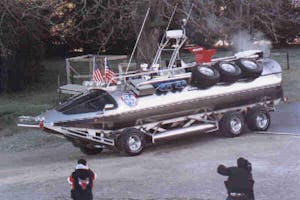
Firetruck to speedster is an unexpected conversion, but what about a 1950s milk truck turned globetrotting boat-car-hybrid? Yep, that’s exactly what award-winning hot rodder Rick Dobbertin cooked up in the early 1990s, dubbing the resulting contraption The Surface Orbiter. Upon its completion, Dobbertin took the Orbiter all over the Western Hemisphere, covering more than 30,000 miles on land and 3000 miles of open ocean in seas up to 18 feet high.
It’s one thing to build a competent land cruiser; it’s another to build a boat capable of traversing the high seas. To build something this good at both? Now that’s something special, and just the right type of strange.
Chevrolet Corphibian
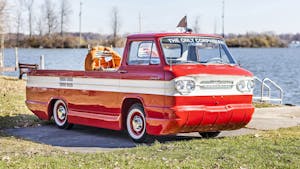
The multipurpose party continues with the third entry on our list, the Chevrolet Corphibian. This oddity started life as a Chevy Rampside pickup before General Motors commissioned Pontiac, Michigan’s Hulten-Holm Co. to slap on a fiberglass hull and teach the truck to swim. In addition to its excellent looks, the Corphibian is thoughtfully laid out: A second set of controls for the steering and the throttle are mounted inside the bed, allowing occupants to enjoy aquatic cruises from the comfort of the truck bed—or, more accurately, the poop deck. The Corphibian pictured here is the only one in existence, and it sold at Mecum’s Kissimmee sale in 2016 for $77,000. You can go see it at the Lane Motor Museum in Nashville, Tennessee.
1932 Helicron Propeller Car

It’s pretty clear what scored the Citröen-powered 1932 Helicron Propeller Car a place on this list. This particular car (the only one of its kind) was discovered in a French barn in 2000. Miraculously, it was preserved in surprisingly good condition and boasts many of its original mechanical components.
Its technological oddity doesn’t stop with that propellor, either; the car steers exclusively through its rear wheels. We’re guessing the wacky one-off drives a bit like horse chariot on loose ice—but we certainly wouldn’t turn down a spin in one. However, we’d need to be especially careful of airborne objects once behind the wheel of this clipped-wing beauty. Especially birds.
Like the Corphibian, this car now resides at the Lane Motor Museum.
1932 Auburn Speedster

Reinan is quite fond of this 1932 Auburn Speedster. From what he can recall, this particular car suffered a crash early on in its lifetime. After the wreck, a particularly enterprising fellow decided that the car should race at Indianapolis in the Indy 500. The Lycoming engine was replaced by a Buick straight-eight in preparation but, though the vehicle did qualify for Indy, it never took the flag. Instead, the pre-war beast raced out east on dirt tracks.
Unsurprisingly, the 1932 Speedster is not a particularly efficient vehicle; Reinan reckons it gets around 4 mpg, drinking copious fuel and air through four two-barrel Rochester carburetors. Still, we can’t stop looking at that gorgeous eight-to-one exhaust pipe.
1916 Hudson Speedster
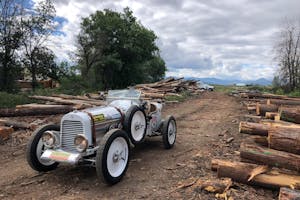
Not all of the vehicles on this list are odd for the sake of attention only. Often a car was considered weird in its day because it introduced a significant mechanical innovation, like this 1916 Hudson Speedster. It was the first vehicle to use a counter-balanced crankshaft, which did wonders to quell the secondary vibrations of its nearly 300-cu-in inline-six. Its vastly improved internal balance meant this engine was one of the first to clear the 2000-rpm mark without shaking itself to pieces.
1936 Scout Scarab

A mere nine examples of the Scout Scarab were built, and only five exist today. Sadly, William Bushnell Stout’s vision for the future proved too progressive for his time. The Scarab featured an extensively interchangeable interior, a rear-mounted Ford V-8, and coil spring suspension on all four corners. Because the engine sat in the rear, the Scarab’s steering wheel and driver’s seat rested almost directly over the front wheels, a configuration somewhat similar to that of forward-control trucks of the 1960s.
Many consider the Stout Scarab to be the pioneering design that would eventually become popular in the minivan—nearly fifty years later.
“The Beast” by John Dodd
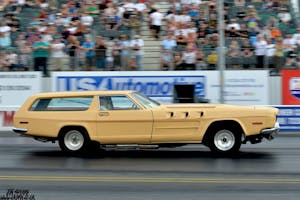
John Dodd’s “The Beast” looks like a Rolls-Royce got friendly with a Camaro in a funhouse mirror. The first iteration of this custom-built monster was advertised in period car magazines as a 200-mph capable car, thanks in part to its Rolls-Royce Meteor tank engine. We love it.
Sadly, the massive oddity burned to the ground—but its determined owner built a second version of The Beast, this time stuffing a 27-liter Rolls-Royce Merlin aircraft engine under the hood. The new bodywork trades the Camaro-esque rear end for that of an AMC Pacer, but the mile-long hood remains. Dodd is now 86 years old and lives in Spain, but he reportedly still takes The Beast out when he can. More power to him, we say.
1913 Cadillac Speedster
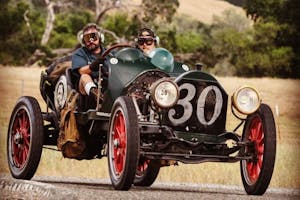
According to Reinan, if the American LaFrance is a reliable (for its time) brick of a speedster, its 1913 Cadillac counterpart is a glass brick—pretty, but far more fragile.
Among the stranger features on this machine are its copper-jacketed cylinders. At one time, Cadillac engineers thought copper jackets would help cool the cylinders on this car’s 360-cubic-inch L-head engine. Though that cooling method didn’t stick around, the 1913 Speedster features another innovation that did. Cadillac had introduced the electric starter only a year before, on the 1912 Model Thirty, and the ’13 Speedster features a version of the then-cutting-edge tech. (Cadillac itself does not own the electric starter patent; that honor belongs to a group of men headed by Charles Kettering and based in Dayton, Ohio.)
Be sure to stick around to hear Jerome describe the catastrophic engine failure that his team once experienced while running a 1913 Speedster in The Great Race—and the car’s incredible resurrection thanks to a robust pre-war Cadillac Facebook community.
“The Decoliner” by Randy Grubb
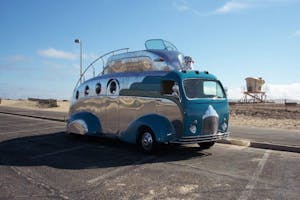
Randy Grubb is a household name in the hotrod and custom car communities, and the Decoliner is one of his most famous creations. It started life as a futuristic (for the time) GMC Motorhome but was heavily modified with a new frame and stainless steel bodywork. There’s a second steering wheel on the bridge you can activate by fastening the steering linkage to the wheel inside the shapely, stainless-steel fuselage, which theoretically allows you to captain the bus like some road-going Art Deco yacht. The best part? Grubb’s currently working on another even larger and more elaborate version, this time with an entire VW bus atop it.
What other vehicles are worthy of this eclectic list? Drop your choice in the Hagerty Community.




